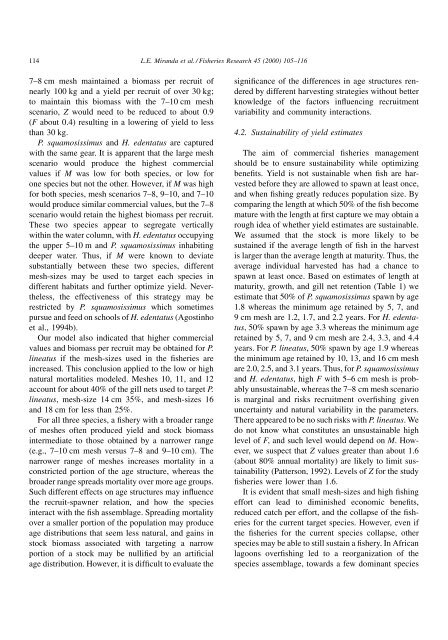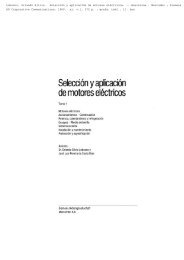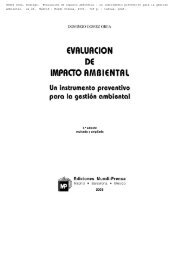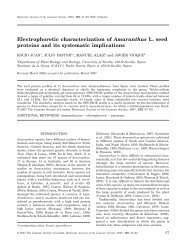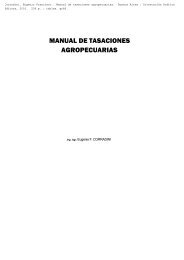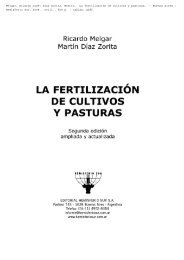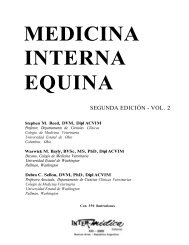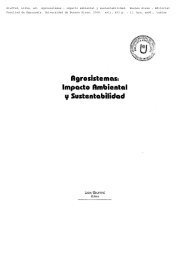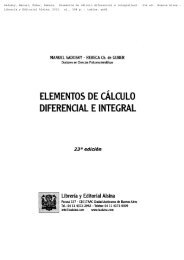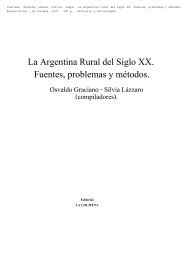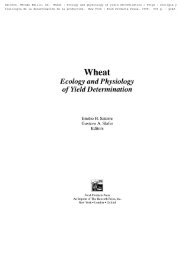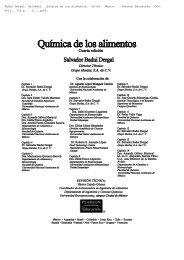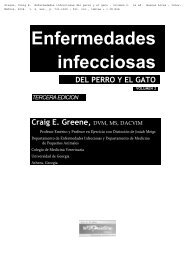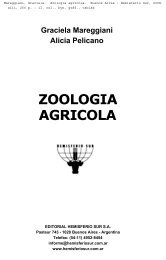Appraisal of the selective properties of gill nets and implications for ...
Appraisal of the selective properties of gill nets and implications for ...
Appraisal of the selective properties of gill nets and implications for ...
You also want an ePaper? Increase the reach of your titles
YUMPU automatically turns print PDFs into web optimized ePapers that Google loves.
114 L.E. Mir<strong>and</strong>a et al. / Fisheries Research 45 (2000) 105±1167±8 cm mesh maintained a biomass per recruit <strong>of</strong>nearly 100 kg <strong>and</strong> a yield per recruit <strong>of</strong> over 30 kg;to maintain this biomass with <strong>the</strong> 7±10 cm meshscenario, Z would need to be reduced to about 0.9(F about 0.4) resulting in a lowering <strong>of</strong> yield to lessthan 30 kg.P. squamosissimus <strong>and</strong> H. edentatus are capturedwith <strong>the</strong> same gear. It is apparent that <strong>the</strong> large meshscenario would produce <strong>the</strong> highest commercialvalues if M was low <strong>for</strong> both species, or low <strong>for</strong>one species but not <strong>the</strong> o<strong>the</strong>r. However, if M was high<strong>for</strong> both species, mesh scenarios 7±8, 9±10, <strong>and</strong> 7±10would produce similar commercial values, but <strong>the</strong> 7±8scenario would retain <strong>the</strong> highest biomass per recruit.These two species appear to segregate verticallywithin <strong>the</strong> water column, with H. edentatus occupying<strong>the</strong> upper 5±10 m <strong>and</strong> P. squamosissimus inhabitingdeeper water. Thus, if M were known to deviatesubstantially between <strong>the</strong>se two species, differentmesh-sizes may be used to target each species indifferent habitats <strong>and</strong> fur<strong>the</strong>r optimize yield. Never<strong>the</strong>less,<strong>the</strong> effectiveness <strong>of</strong> this strategy may berestricted by P. squamosissimus which sometimespursue <strong>and</strong> feed on schools <strong>of</strong> H. edentatus (Agostinhoet al., 1994b).Our model also indicated that higher commercialvalues <strong>and</strong> biomass per recruit may be obtained <strong>for</strong> P.lineatus if <strong>the</strong> mesh-sizes used in <strong>the</strong> ®sheries areincreased. This conclusion applied to <strong>the</strong> low or highnatural mortalities modeled. Meshes 10, 11, <strong>and</strong> 12account <strong>for</strong> about 40% <strong>of</strong> <strong>the</strong> <strong>gill</strong> <strong>nets</strong> used to target P.lineatus, mesh-size 14 cm 35%, <strong>and</strong> mesh-sizes 16<strong>and</strong> 18 cm <strong>for</strong> less than 25%.For all three species, a ®shery with a broader range<strong>of</strong> meshes <strong>of</strong>ten produced yield <strong>and</strong> stock biomassintermediate to those obtained by a narrower range(e.g., 7±10 cm mesh versus 7±8 <strong>and</strong> 9±10 cm). Thenarrower range <strong>of</strong> meshes increases mortality in aconstricted portion <strong>of</strong> <strong>the</strong> age structure, whereas <strong>the</strong>broader range spreads mortality over more age groups.Such different effects on age structures may in¯uence<strong>the</strong> recruit-spawner relation, <strong>and</strong> how <strong>the</strong> speciesinteract with <strong>the</strong> ®sh assemblage. Spreading mortalityover a smaller portion <strong>of</strong> <strong>the</strong> population may produceage distributions that seem less natural, <strong>and</strong> gains instock biomass associated with targeting a narrowportion <strong>of</strong> a stock may be nulli®ed by an arti®cialage distribution. However, it is dif®cult to evaluate <strong>the</strong>signi®cance <strong>of</strong> <strong>the</strong> differences in age structures renderedby different harvesting strategies without betterknowledge <strong>of</strong> <strong>the</strong> factors in¯uencing recruitmentvariability <strong>and</strong> community interactions.4.2. Sustainability <strong>of</strong> yield estimatesThe aim <strong>of</strong> commercial ®sheries managementshould be to ensure sustainability while optimizingbene®ts. Yield is not sustainable when ®sh are harvestedbe<strong>for</strong>e <strong>the</strong>y are allowed to spawn at least once,<strong>and</strong> when ®shing greatly reduces population size. Bycomparing <strong>the</strong> length at which 50% <strong>of</strong> <strong>the</strong> ®sh becomemature with <strong>the</strong> length at ®rst capture we may obtain arough idea <strong>of</strong> whe<strong>the</strong>r yield estimates are sustainable.We assumed that <strong>the</strong> stock is more likely to besustained if <strong>the</strong> average length <strong>of</strong> ®sh in <strong>the</strong> harvestis larger than <strong>the</strong> average length at maturity. Thus, <strong>the</strong>average individual harvested has had a chance tospawn at least once. Based on estimates <strong>of</strong> length atmaturity, growth, <strong>and</strong> <strong>gill</strong> net retention (Table 1) weestimate that 50% <strong>of</strong> P. squamosissimus spawn by age1.8 whereas <strong>the</strong> minimum age retained by 5, 7, <strong>and</strong>9 cm mesh are 1.2, 1.7, <strong>and</strong> 2.2 years. For H. edentatus,50% spawn by age 3.3 whereas <strong>the</strong> minimum ageretained by 5, 7, <strong>and</strong> 9 cm mesh are 2.4, 3.3, <strong>and</strong> 4.4years. For P. lineatus, 50% spawn by age 1.9 whereas<strong>the</strong> minimum age retained by 10, 13, <strong>and</strong> 16 cm meshare 2.0, 2.5, <strong>and</strong> 3.1 years. Thus, <strong>for</strong> P. squamosissimus<strong>and</strong> H. edentatus, high F with 5±6 cm mesh is probablyunsustainable, whereas <strong>the</strong> 7±8 cm mesh scenariois marginal <strong>and</strong> risks recruitment over®shing givenuncertainty <strong>and</strong> natural variability in <strong>the</strong> parameters.There appeared to be no such risks with P. lineatus.Wedo not know what constitutes an unsustainable highlevel <strong>of</strong> F, <strong>and</strong> such level would depend on M. However,we suspect that Z values greater than about 1.6(about 80% annual mortality) are likely to limit sustainability(Patterson, 1992). Levels <strong>of</strong> Z <strong>for</strong> <strong>the</strong> study®sheries were lower than 1.6.It is evident that small mesh-sizes <strong>and</strong> high ®shingef<strong>for</strong>t can lead to diminished economic bene®ts,reduced catch per ef<strong>for</strong>t, <strong>and</strong> <strong>the</strong> collapse <strong>of</strong> <strong>the</strong> ®sheries<strong>for</strong> <strong>the</strong> current target species. However, even if<strong>the</strong> ®sheries <strong>for</strong> <strong>the</strong> current species collapse, o<strong>the</strong>rspecies may be able to still sustain a ®shery. In Africanlagoons over®shing led to a reorganization <strong>of</strong> <strong>the</strong>species assemblage, towards a few dominant species


